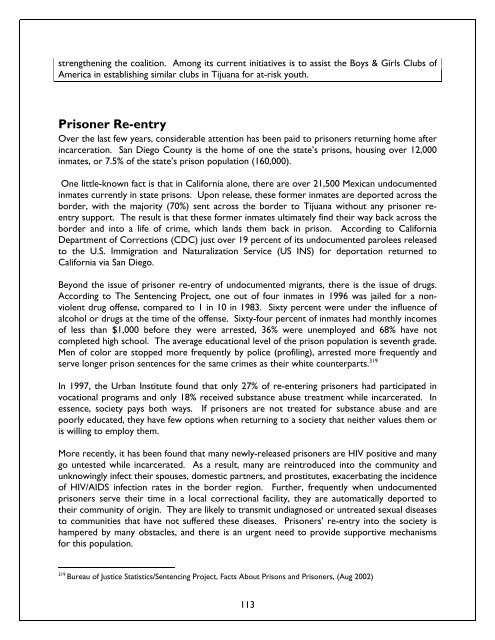Blurred Borders - International Community Foundation
Blurred Borders - International Community Foundation
Blurred Borders - International Community Foundation
You also want an ePaper? Increase the reach of your titles
YUMPU automatically turns print PDFs into web optimized ePapers that Google loves.
strengthening the coalition. Among its current initiatives is to assist the Boys & Girls Clubs of<br />
America in establishing similar clubs in Tijuana for at-risk youth.<br />
Prisoner Re-entry<br />
Over the last few years, considerable attention has been paid to prisoners returning home after<br />
incarceration. San Diego County is the home of one the state’s prisons, housing over 12,000<br />
inmates, or 7.5% of the state’s prison population (160,000).<br />
One little-known fact is that in California alone, there are over 21,500 Mexican undocumented<br />
inmates currently in state prisons. Upon release, these former inmates are deported across the<br />
border, with the majority (70%) sent across the border to Tijuana without any prisoner reentry<br />
support. The result is that these former inmates ultimately find their way back across the<br />
border and into a life of crime, which lands them back in prison. According to California<br />
Department of Corrections (CDC) just over 19 percent of its undocumented parolees released<br />
to the U.S. Immigration and Naturalization Service (US INS) for deportation returned to<br />
California via San Diego.<br />
Beyond the issue of prisoner re-entry of undocumented migrants, there is the issue of drugs.<br />
According to The Sentencing Project, one out of four inmates in 1996 was jailed for a nonviolent<br />
drug offense, compared to 1 in 10 in 1983. Sixty percent were under the influence of<br />
alcohol or drugs at the time of the offense. Sixty-four percent of inmates had monthly incomes<br />
of less than $1,000 before they were arrested, 36% were unemployed and 68% have not<br />
completed high school. The average educational level of the prison population is seventh grade.<br />
Men of color are stopped more frequently by police (profiling), arrested more frequently and<br />
serve longer prison sentences for the same crimes as their white counterparts. 319<br />
In 1997, the Urban Institute found that only 27% of re-entering prisoners had participated in<br />
vocational programs and only 18% received substance abuse treatment while incarcerated. In<br />
essence, society pays both ways. If prisoners are not treated for substance abuse and are<br />
poorly educated, they have few options when returning to a society that neither values them or<br />
is willing to employ them.<br />
More recently, it has been found that many newly-released prisoners are HIV positive and many<br />
go untested while incarcerated. As a result, many are reintroduced into the community and<br />
unknowingly infect their spouses, domestic partners, and prostitutes, exacerbating the incidence<br />
of HIV/AIDS infection rates in the border region. Further, frequently when undocumented<br />
prisoners serve their time in a local correctional facility, they are automatically deported to<br />
their community of origin. They are likely to transmit undiagnosed or untreated sexual diseases<br />
to communities that have not suffered these diseases. Prisoners’ re-entry into the society is<br />
hampered by many obstacles, and there is an urgent need to provide supportive mechanisms<br />
for this population.<br />
319 Bureau of Justice Statistics/Sentencing Project, Facts About Prisons and Prisoners, (Aug 2002)<br />
113















